~ 13 ~
~ The Study of Threes ~
http://threesology.org
Researchers as of 8/29/2019
| Devil's Advocate Series: | ||||||||
|---|---|---|---|---|---|---|---|---|
| 1 | 2 | 3 | 4 | 5 | 6 | 7 | 8 | 9 |
| 10 | 11 | 12 | 13 | 14A 14B |
15 | 16 | 17 | 18 |
| 19 | 20 | 21 | 22A 22B |
23 | 24 | 25 | 26 | 27 |
| 28 | 29 | 30 A | 30 B | 31 | 32 | 33a | 33b | 33c |
| 34 | 35 | 36 | 37 | 38 | 39 | 40 | 41 A | 41 B |
I've been contemplating this page for several days. As I was putting together the preliminary timeline for the 1st page in this series, I came to reflect on the question which might be posed by some when they begin to review the information to be found associated with the timeline and the information on the pages which follow the introduction. The question being: Why didn't I and why haven't I pursued the information for the timeline in a start-to-finish format? In other words, why is there no singular effort to complete the timeline by installing sequential information from the Big-Bang up to the present day? The simplest answer would be to describe it with an analogy where Darwin is thinking about the discussions (in his day) involving "transmutation of species" which were later enveloped into the idea of evolution by descent, without him having gone on a five year specimen journey, the most notable stop-over being at the Galapagos islands. In short, a collection of threes is a collection of different species of ideas being developed by humans, many of which show similarities. Whereas anyone can make a collection of one or another number-related pattern from different subjects, it is quite another to transform the idea into a working hypothesis, much less bring it to the fruition of a developmental theory that may eventually prove to be testable.
Imagine if Darwin had not made his collections for later study. Would he have been able to use the absence of so many examples to generate the same resulting opinions? If he had not collected examples from an isolated habitat which offered multiple variations of a similar underlying framework, would he have been able to generate the same conclusions in the time and manner that he did? The same goes for a collection of threes (an non-threes) examples within the "isolated habitat" of a given subject such as biology, or physics, or sociology, or any other terrain one may venture into and begin exploring with the vernacular of those versed in the respective cultures... without "going native" in order to preserve some level of objectivity. As it stands, every single subject is an isolated habitat which produces its own types of foraging species with and without mutations.
While terrains do overlap and often blend into one another, thus producing those whose wide ranging knowledge make them become described as a polymath, though such a term used in the past was related to those who became exposed to multiple ideas that today might be defined as generalities or simplicities by today's standards of erudite knowledge, and that the erudite knowledge of today is so deep in many respects, that those who are referred to as polymaths are not necessarily so. In other words, if we were to apply (to present day average people) the definition of a past era polymath who were privileged to acquire a larger knowledge than most people in their day and age (who were quite ignorant because of a lack of public education, public libraries, social media communications, etc...), many average people today might well be viewed as a genius in their own right, despite a lack of skills for painting, creating music, or performing even simple algebraic sums. Whereas a person today might not be able to apply a knowledge of plumbing, electricity or mechanics due to a lack of such technologies in the past, a knowledge or carpentry, animal husbandry, metallurgy, gardening, construction, first aid and other skills would come in handy in more primitive settings. Even an ability to speak in public might well amaze a given group because of an increased vocabulary (though people in the past may well have had a small vocabulary and limited understanding of multiple words), not to mention the thinking strategies being exhibited in what is sometimes referred to as "business street smarts", which many an average person has.
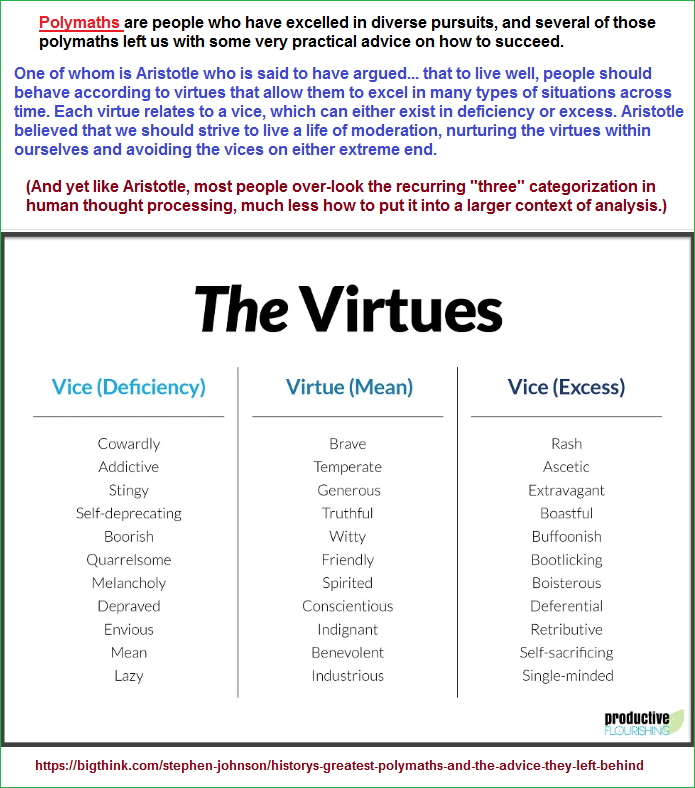
3 Brilliant Polymaths, and the Advice They Left Behind by Stephen Johnson, 20 June, 2017
While many of the "threes" similarities take place within the subject of biology, these can be correlated to ideas found in other subjects... as if they are adaptations of the same species (of mental activity?) through descent over time... while a few change so dramatically as to give the impression of being a different species of human cognition. Indeed, mimicry of ideas does take place, but so do original conceptualizations... though we must take into account creative adaptations of old idea patterns. If they are truly different species, then we may be distinguishing between that which may be termed an "identification of the analytically obvious", and that which may be construed as a "commonly occurring subtle change" in the human mind due to internal and/or external influences. In other words, while the differences can be seen by those analyzing the data with intensity, it is overlooked by the casual observer. And the professional observers are well can be just as blind to the obvious as the general sight-seeing person with a cursorial interest in a particular subject. For example, since we are dealing with language in describing most of the threes examples, and that hearing plays a dominant role in articulation, it would seem rather obvious that those interested in ideas would also be interested in the process of hearing, which is filled with patterns-of-three, as mentioned on an earlier page:
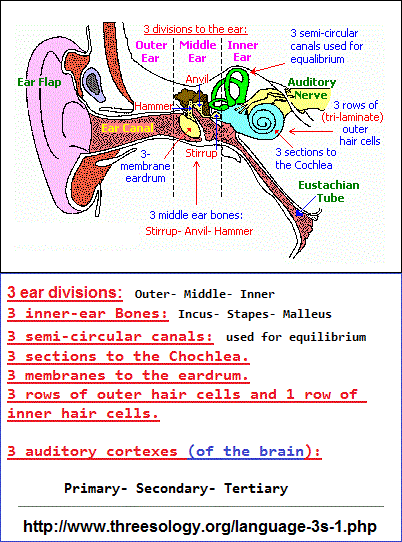
An excursion into a discussion of "three" as both a quantity and quality, necessarily involves a reference to both Language and its reliance on Hearing. If we look at the structure of the ear so closely connected to the brain and whose functioning is necessary to detect any problems which could interfere with developmental milestones in language and socialization where the primary, secondary and tertiary auditory cortexes come into play. With respect to the number of turns in the Cochlea: {1} "The number of human cochlear turns is generally accepted being 2 1/2, although cases with up to 2 3/4 or even 3 turns are known from literature." (On the number of turns in human cochlea.) {2} "It is a spiral-shaped cavity in the bony labyrinth, in humans making 2 turns(full) and a 3/4(3 quarters) turn around its axis, the modiolus". (Cochlea) {3} "The scalae wind around the modiolus ~3 times, defining apical, middle and basal turns". {Hearing and Balance}. The point to be made with hearing is that because there is a repetitive pattern-of-three associated with the ear and that many, many, many ideas also reflect this same pattern, it stands to consider that this pattern has an effect on language (just look at deaf people having a difficult time with the articulation of words), and that (as it has been previously proposed by others), language has an effect on ideas. If the ear exhibited a different recurring pattern, language as well as our ideas might well have a different recurring pattern. Take a look at the many pattern-of-three ideas in philosophy as a representative Trichotomy, which is a list which used to contain a reference to my earlier list (from which the idea arose): Threes Poster (5th column), after I had placed the list onto a Wikipedia page but someone connected with Wikipedia got the idea to exclude my contribution so as to give the impression that the author should be given credit for their "original" idea. These pattern-of-three ideas provide us with a tell-tale indication that either everyone is copying everyone else, or that there is "something" to the recurrence... though not necessarily the ideas be fostered by the originators of the different three-patterned ideas. Let's take a closer look at some of the three-patterned structures in the ear: | ||
3 Scala Turns |
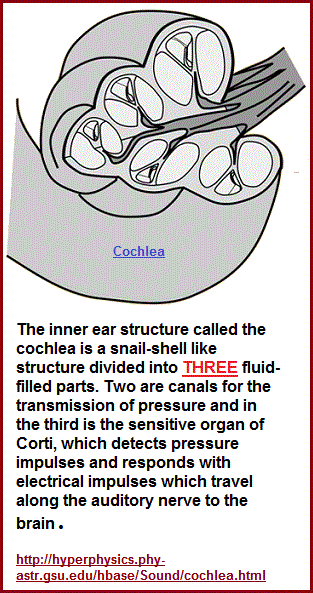 |
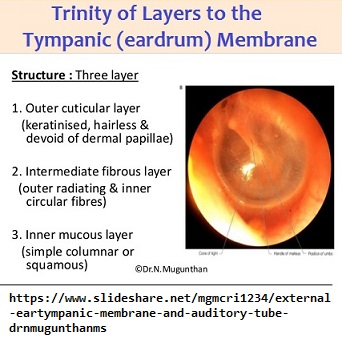 |
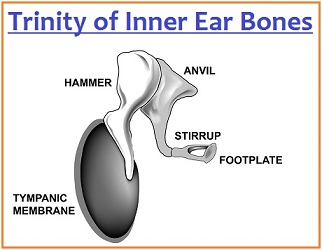 |
 |
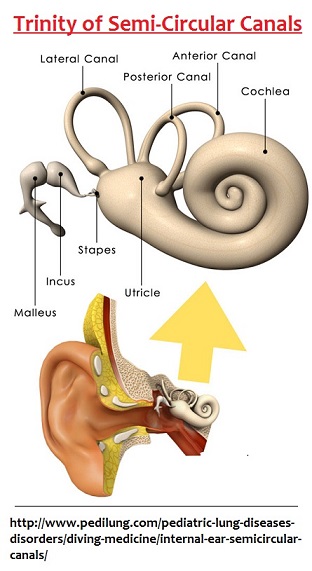 |
I am not talking (descriptively metaphorical) about different colors or garments being worn over the same kinds of thoughts, but actual different forms of thinking, suggesting the occurrence of a developmental trend in the brain... presenting us with different species of brain processing. An analogy might be to suggest that the brain processing of an Australopiticine was a different species of cognition than that used by Neandethals, which might well be expected because of the vast differences between them. Yet if we were to witness such "wide-span" differences occurring amongst people who looked and generally acted the same because of social requirements to perform a variety of activities in the same manner because of functionality (for example, the design of a vehicle requires basic behaviors for the operation thereof); we would have the presence of a different human species... like modern humans placed in the midst of some earlier hominid group that they must either mimic to "look normal", or band together and create their own niche', like many a person does when attempting to seek out those with the same mindset as themselves.
Let's take another look at the preliminary of the Timeline I am putting together and had placed on page one in this Devil's Advocate series:
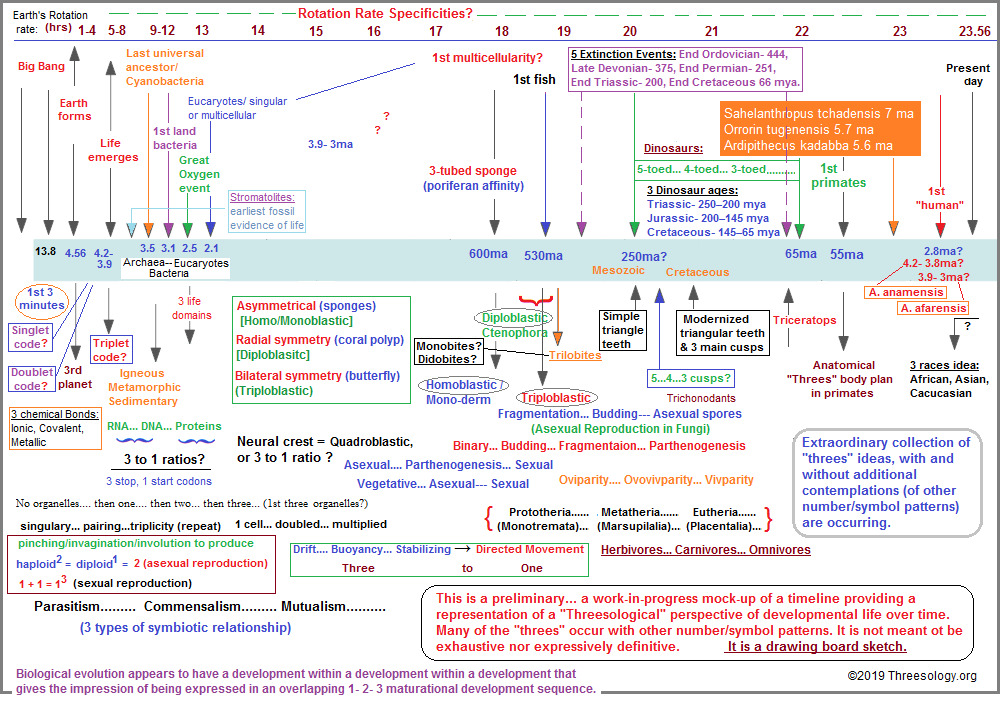
Only by providing a visual representation of what I am working on do many readers come to at least simplistically appreciate what information is being gathered and for what (preliminary) purpose. Each reader from their own vantage point can thus dive deep into their respective interest(s) and come up with an example to be placed onto the timeline, but they would not do so without such an image. Writing about it and showing an image are separate communication devices. Without providing a timeline, the collection of threes may appear to be just another type of hoarding behavior without any direction except to make a compilation like someone collecting a bunch of old cars, motorcycles, jars, bottles, magazines, newspapers, etc..., without any relevance to anything other than being a collection compiled in a way that suits the interest of a given collector. However, the numerous instances of "threes" in biology alone, either tells us that there is a repetition that is an indication of an imposed constraint on biological processes, or that the pattern reveals a repetitive mindset of humanity that is caught in a loop... for one another reason that is not being looked seriously at. If the pattern-of-threes and other low number value patterns in biology is not inherent in the biological processes themselves... that they are imaginatively contrived by the human mind, then this may reveal a type of overlooked autism being expressed by human behavior. Why biological processes do not express large number activities or why humanity can not put such processes into larger number staging processes, is something we need to analyse.
First of all, much of the information is scattered here and there... even when one takes up reading a textbook which attempts to give the impression of providing information from the earliest of biological beginnings till today. While some textbooks try to be sequentially informative, the authors have their own preferences as to what information in what order that they think is most relevant for a particular course and readership. While there may or may not be an observable agenda with regards to building on a deduced pattern that a particular author or group of authors feel is most relevant for the material in the way it is being provided, this pattern is not necessarily conducive to a Threesological profile as it is being offered. Take for example the already mentioned Calvin Cycle. While many an author point out the repetition of 3 carbon sugars, they are not doing so with an effort to describe a "threes" repetition within and concurrent with other subject matter. If not the three-carbon sugars, another author may point out an alternative "three" without being aware of the "threes proclivity" occurring in other biological models and outside of biology as well, thus referring to a repetitive cognitive profile of humans. I on the other hand am striving to point this out with an accompanying discussions as to why. Indeed, if the patterns-of-three being uncovered in an expose' are not an inherent part of that being studied, they the study necessarily turns to an analysis of why so many scientific models use a "three". If the model is merely a contrivance, why is the contrivance a repetition of "three" in one way or another with the language/vernacular of the subject or topic in question?
For every three turns of the Calvin cycle, three atoms of carbon are fixed from three molecules of carbon dioxide. In the carbon fixation stage, carbon dioxide is attached to RuBP by the enzyme rubisco. The resulting 6-carbon product quickly splits into two molecules of a three-carbon compound (3-phosphoglycerate).The Calvin cycle reactions can be divided into three main stages: carbon fixation, reduction, and regeneration of the starting molecule.
- Carbon fixation A CO2 molecule combines with a five-carbon acceptor molecule, ribulose-1,5-bisphosphate (RuBP). This step makes a six-carbon compound that splits into two molecules of a three-carbon compound, 3-phosphoglyceric acid (3-PGA). This reaction is catalyzed by the enzyme RuBP carboxylase/oxygenase, or rubisco.
- Reduction In the second stage, ATP and NADPH are used to convert the 3-PGA molecules into molecules of a three-carbon sugar, glyceraldehyde-3-phosphate (G3P). This stage gets its name because NADPH donates electrons to, or reduces, a three-carbon intermediate to make G3P.
- Regeneration Some G3P molecules go to make glucose, while others must be recycled to regenerate the RuBP acceptor. Regeneration requires ATP and involves a complex network of reactions, which my college bio professor liked to call the "carbohydrate scramble."
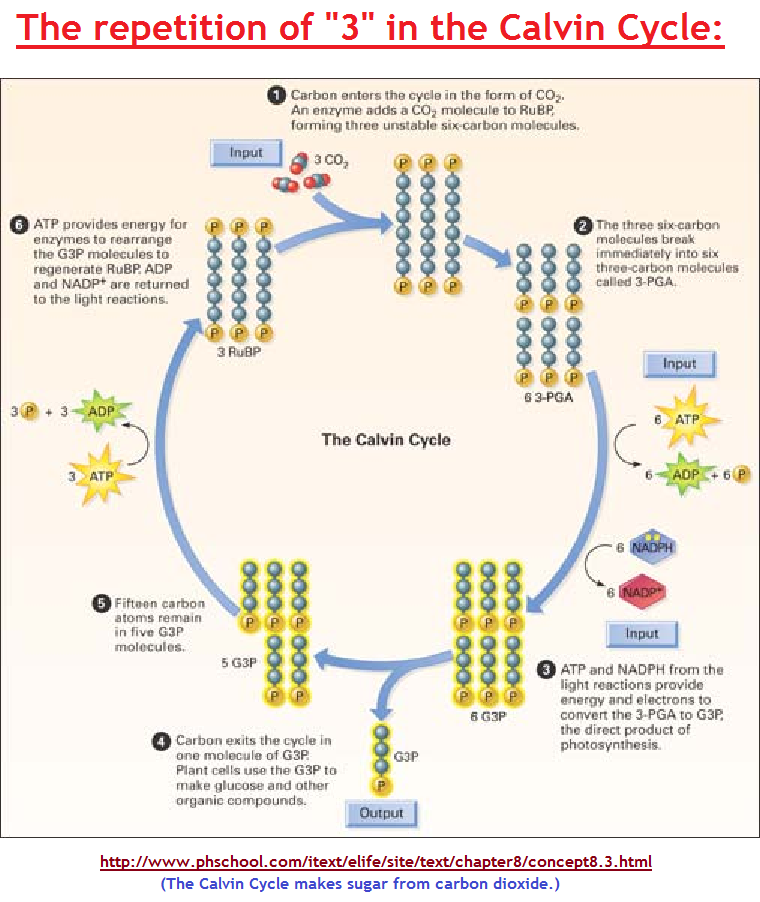
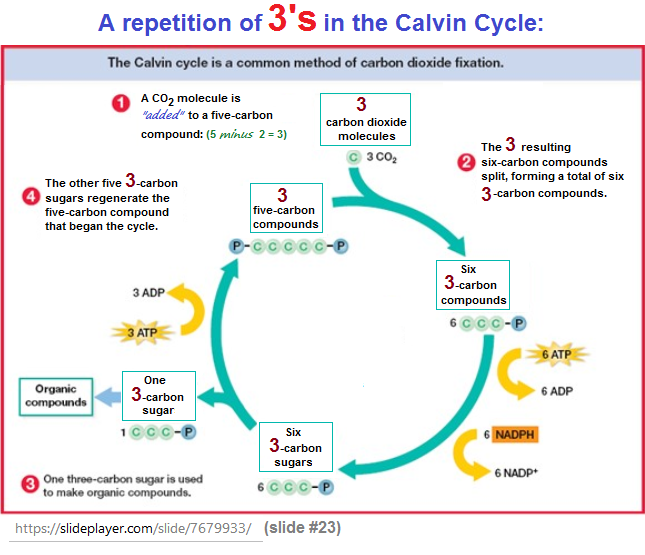
If we simply take this "three" example by itself and isolate it by a mindset of ownership in terms of becoming an expert about the Calvin Cycle and not look beyond the fixation of scientists whose "ownership" of a given biological aspect tends to make them blind to other perceptions occurring outside the boundaries of their specialized interest, there is no repetition to be sighted except that for which a person has a singular interest in. The old adage of a person not being able to see the forest for the trees comes into play. What gains the primacy of importance is to acquire some mastery for the purposes of getting a good grade in an academic class in preparation for more advanced studies... in a stepping stone fashion, so long as those studies are within the context of conventionalities which a study of threes is not.
Attempting to mention to someone who is aware of the "threes" in the Calvin Cycle that there exists other patterns-of-three in biology (and elsewhere), may have little interest for them since their mentors do not speak of any correlations to be made that holds any significance for them. It's like talking to an old farmer about a new method of cultivation and they have little interest in learning anything beyond the traditions of their day-to-day routinized traditions of thinking.
Likewise, if one were not aware that the Citric Acid cycle is alternatively named the Krebs cycle and the Tricarboxylic acid cycle the "three" prefix of the latter name may not have any bearing in terms of a larger threesological disposition of analysis by those whose mindset is singularly focused inward.
However, while this is an easily seen repetition of "threes", some examples must be pointed out by a singular deduction, such as when describing the presence of a 3-to-1 ration in DNA and RNA... because such an observation in either mainstream or the sub-cultural perceptions of genetics doesn't exist. I am creating the observations for the first time. As such, the patterns may not "register" on the consciousness of most people since it is not being focused on in general texts or books written by popular science writers. They simply are not aware of such patterns.
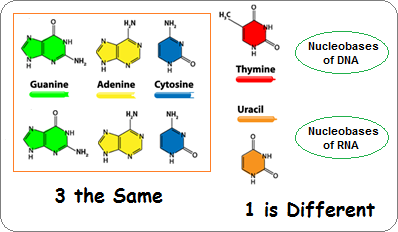
Study of Threes page 1
Yet, this still does not adequately answer the question of why I don't proceed sequentially when all the above is taken into account. The problem exists in the fact that information about sequential events is not appreciably known by anyone, despite the different varieties of timeline one encounters. While they look good at first appearance to those who are not familiar with the data in the first place, or those whose knowledge about a given subject remains in a generalized state of personal development that simply seeks one another confirmation of their inadequate knowledge as if it were some high achievement. Timelines typically represent generalities with one another specificity added to give the presumption of directed authenticity and comprehensiveness. The sequential events of many a timeline are presently in a stage of development from a generalized perspective, even though we have individual experts scrutinizing specialized areas of those generalities in serious ways. Timelines are typically meant as over-views, though some do attempt to provide greater details than others. Researchers are often-times so intently focused on a small segment of research they are not making any larger correlations between the vast horde of information available... though many do strive to include divergent considerations from multiple subject areas, albeit within the strictures of conventionalized interests. In short, there is a ton of information that needs to we waded through and lots of the information being provided is still in a developmental stage. Like some poets, artists and musicians whose work acquires an interpretation which exceeds their own description, those studying different academically trained subjects can become quite irritated by those who come to point out far more expansive ideas about their research than they do.
For example, for a long time it was thought that there were only two color receptors in the eyes (the cones and rods), and now we find there are three: Rods, cones, and intrinsically photosensitive retinal ganglion cells. If a "threes" researcher takes the "two" reference found in multiple more documents than the "three" reference as being a representation of truth, their compilation of threes will be incorrect, thus perhaps leading them along a diverged path of inquiry that is not as fruitful as does a threes reference. In fact, it may not even be recorded, as is the case with those whose interest in a singular pattern are oriented to disregard those patterns which are not plainly seen versions of that which they are focused on. And yet, the absence of one's pattern interest is a pattern, just as the recurrence of patterns with a low number value.
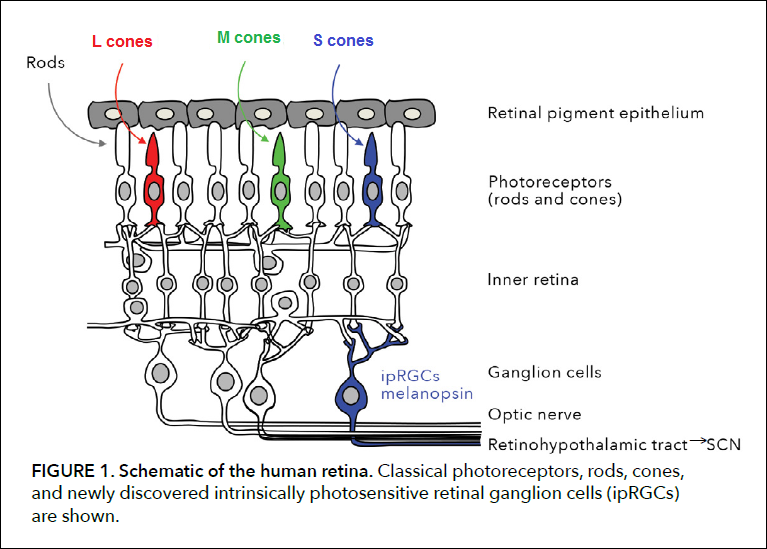
Research gate: (Search for: Chapter 4 Daylight in the built environment in the "Changing perspectives on daylight: Science, technology, and culture" A Sponsored Supplement to Science)
Interestingly, the 3-to-1 ratio we see in DNA and RNA, (which includes the 3 stop and 1 start codons as another example)... can be seen in the eyes, since there is 1 rod and 3 cones. Here is a short except about the rods and cones with respect to color vision:
Unlike rods, which contain a single photo-pigment, there are three types of cones that differ in the photo-pigment they contain. Each of these photo-pigments has a different sensitivity to light of different wavelengths, and for this reason are referred to as "blue," "green," and "red," or, more appropriately, short (S), medium (M), and long (L) wavelength cones, terms that more or less describe their spectral sensitivities. This nomenclature implies that individual cones provide color information for the wavelength of light that excites them best. In fact, individual cones, like rods, are entirely color blind in that their response is simply a reflection of the number of photons they capture, regardless of the wavelength of the photon (or, more properly, its vibrational energy). It is impossible, therefore, to determine whether the change in the membrane potential of a particular cone has arisen from exposure to many photons at wavelengths to which the receptor is relatively insensitive, or fewer photons at wavelengths to which it is most sensitive. This ambiguity can only be resolved by comparing the activity in different classes of cones. Based on the responses of individual ganglion cells, and cells at higher levels in the visual pathway), comparisons of this type are clearly involved in how the visual system extracts color information from spectral stimuli. Despite these insights, understanding of the neural mechanisms that underlie color perception has been elusive.
Cones and Color Vision
Yet, the development of vision from the earliest of organisms has to be included in the timeline with respect to identifying a "three" or an absence thereof. Is there a 1-2-3 developmental sequence with the cones? Why aren't their 3 types of rods? Why only three types of photo-receptors? How does the numerical arrangement affect human perception? Will there be two more forthcoming in the centuries ahead, or will humanity change itself into another type of species for long distance space flight or living in space?
Because I am getting my research data from other researchers who have been or are active in their respective field of inquiry; if they have a proclivity for some other-than-three orientation, their commentary about their research may well reflect this orientation, leaving me to reinterpret whatever information they provide with a threesological lens. They may, for one reason or another, deliberately, inadvertently, or off-handedly be dismissive of revealing the presence of a "three" or anything suggestive thereof. For example, a researcher may be more inclined to discuss the presence of the double helix in DNA and the single strand in RNA, and not stop to think that this "1-2" arrangement is a sequential development that may reveal a developmental trend towards the presence of a triple strand... or not, and we need to understand the reason(s) for any further development or lack thereof. If the 1- and 2- stranded items came about by the presence of a certain environmental condition and there is no further development towards a triple strand, what in the environment has changed? That is if the strandedness was on a 1-2-3 developmental course, or is simply a primitive variation of a "two sequence" to be replaced by a one-two-three formula later on... if such environmental conditions can come about. Nonetheless, aside from all the philosophical speculation, if a researcher has a proclivity that orients them towards an other-than-three perception, they may be inclined to emphasize another pattern such as a two... for example, the two strands, double amino acid combinations, RNA/DNA, and Thymine/Uracil. The triplet code, the 3 start and 1 stop codons, the 3 to 1 ratio, and the idea of a triple strandedness may not even be mentioned with any regularity.
The development of new ideas takes a lot of information that is not necessarily in the order one is contemplating about a given pattern of arrangement. An arrangement which may be altered with each addition of different information. In collecting different examples of "threes" from various subjects, one must begin to at least mentally collate them into representative piles or categories, all the while knowing that the initial piles may be titled with superficial headings that will need to be changed later on. There is no telling how many people in the world are making their own collections of different items who may never process the information into any usefulness because they are little more than hoarders without direction. Like numerologists who simply spend their lives collecting different examples of different number associated patterns, but do little else with their collections but create a numerological listing which serves like a list of chores to be attended to in a given order, and be used as the method by which one carries out a recurring routine. They do not recognize, or at least do not make public, any recognition that their lists of number-related items generally expose the recurrent usage of low number values. And they may or may not collate different number patterns with different subjects.
While their lists can be of general usage since they may contain examples one has not recognized on their own, they can not be assumed to be definitive for any number pattern, much less combinations and inter-relatedness.
Different people may be making similar collections and begin devising similar ideas, such as in the case of Charles Darwin and Alfred Russel Wallace, both of whom were British Naturalists. However, there may have been others elsewhere who were not recognized as Naturalists that were or had already created their own versions of Evolution. History simply does not provide us with a readily available reference to such a possibility. Such a possibility is rather disconcerting not only in biology, but other subjects where noted individuals in a given field can be upstaged by not only someone who is unknown, but also unknown in a given field of research. If you are not also an outsider (such as women have been in many fields of research), as well as little recognized for having an interest in a given subject (such as an unrecognized amateur), any discovery you have made may be called into question... but would not be if you were recognized for being a researcher. Then again, many a student (such as a younger sister of mine), may have their ideas stolen from an academian who was in charge of assisting them in over-seeing a dissertation. Just like my experiences in the field of social work, there are a lot of back-stabbing co-workers who will do anything to make themselves look good at your expense. Scientists, like politicians and theologians can be very nasty people at times.
In mentioning Darwin and Wallace, let me provide a short refrain of an historical excerpt detailing the collecting of specimens and the precursor events leading up to the idea of Evolution:
Darwin and His Theory of Evolution At first glance, Charles Darwin seems an unlikely revolutionary. Growing up a shy and unassuming member of a wealthy British family, he appeared, at least to his father, to be idle and directionless. But even as a child, Darwin expressed an interest in nature. Later, while studying botany at Cambridge University, he was offered a chance to work as an unpaid naturalist on the HMS Beagle, a naval vessel embarking on an exploratory voyage around the world. In the course of nearly five years at sea – during which time the Beagle surveyed the coast of South America and stopped in such places as Australia and, most famously, the Galapagos Islands – Darwin took advantage of countless opportunities to observe plant and animal life and to collect both living and fossilized specimens for later study.
After the Beagle returned to England in October 1836, Darwin began reflecting on his observations and experiences, and over the next two years developed the basic outline of his ground-breaking theory of evolution through natural selection. But beyond sharing his ideas with a close circle of scientist friends, Darwin told no one of his views on the origin and development of life. Indeed, he did not publish his now-famous volume, On the Origin of Species by Means of Natural Selection, until 1859, more than 20 years after he had first formulated his theory.
On the Origin of Species may never have been written, let alone published, if it had not been for Alfred Russel Wallace, another British naturalist who independently proposed a strikingly similar theory in 1858. Wallace’s announcement prompted Darwin to publicly reveal that his own research had led him to the same conclusion decades earlier. This being the age of Victorian gentlemen, it was agreed that the two scientists would jointly publish their writings on the subject. Their work – comprising a collection of Darwin’s earlier notes and an essay by Wallace – was read to the Linnean Society, an association of naturalists, in London on July 1, 1858. The following year, Darwin published On the Origin of Species, a lengthy, fleshed-out treatment of his ideas on evolutionary theory. The book was an immediate bestseller and quickly set off a firestorm of controversy...
Darwin and His Theory of Evolution
While anyone can look about them and see that there are multiple examples of different number-assigned patterns to be observed, and various collections to be made thereof, arranging those patterns in a more useful pattern of interpretation can further our knowledge— not only about individual instances of specific subject-related criteria, but human cognition as well. If the number-related patterns humans are identifying in different subject materials is not inherent in the material being studied... because the patterns are merely "convenient contrivances" for study and discussion, then such patterns reflect a repetitious mentality that must have some influence. If this recurring usage of low number-related patterns gives an indication of changing over time, this may mean that whatever is influencing the re-usage is being altered. Humanity must become aware of such an influence... whether it is stable, fluctuating, intermittent, or unstable in the sense of flip-flopping like the polarization of the Earth... that is a predictable quirk as is outlined here: No, We're Not All Doomed by Earth's Magnetic Field Flip.
Identifying the number-related patterns of biological events may lead us to identify that the presumed stability of DNA is not unchangeable, and that this change may occur very rapidly... or that it is to our advantage to artificially force it to change very quickly in preparation for a future life elsewhere in space as a different type of species. Thus rendering all the present day human interests (politics, religion, business, entertainment, etc.,) as a bunch of nonsense. Then again, this supposition may be way off base as to what may be revealed by creating a larger collection of number-labeled perceptions called theories, laws, processes, stages, classes, kinds, types, etc...
Then again, if Darwin had not done what he did, would we then be focused on Wallace as the father of Evolution... though others no doubt contributed to the ideas for which they are singularly credited for? Similarly, if I don't make an attempt to promote the need for creating more intensely studied number-related patterns from an unconventionalized approach, no doubt someone else may well do so... if not now, then sometime in the future... particularly if they were to come across the different lists of number-related compilations of ideas found here and there. Surely someone at sometime would come to develop one or more correlations which step beyond the boundaries of conventional ideas concerning the recurrence of some number patterns more than others... and that the larger collection provides evidence of a low number usage suggestive of an imposition on human thinking. In other words, as I have noted several times before in other commentary, when we take a larger stock of all the number patterns from different subjects, there is a widespread occurrence of patterns exhibiting the values of one through 10, though there are exceptions... and there is a stark absence of ideas which use large number patterns. It's not that humanity can't think in large numbers, there is just an inclination (one may assume), for using certain low number values to express ideas. Regardless of the rationalization one uses to explain the situation, the fact that it occurs needs to be looked at from a different vantage point.
Origination date (of page heading:) Wednesday, September 4th, 2019... 11:32 AM
Begin writing: Thursday, September 5th, 2019... Approx. 1:30 AM
Initial Posting: Thursday September 5th, 2019... 12:57 PM
Updated Posting:Tuesday, January 17th, 2023... 12:19 AM
Herb O. Buckland
herbobuckland@hotmail.com